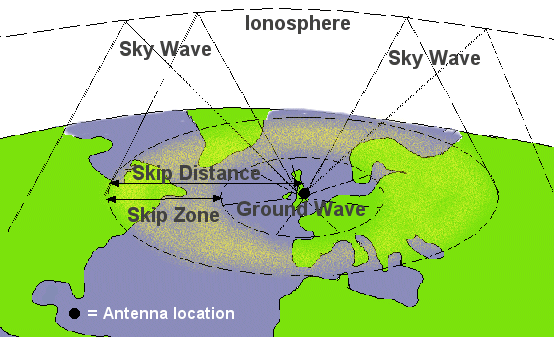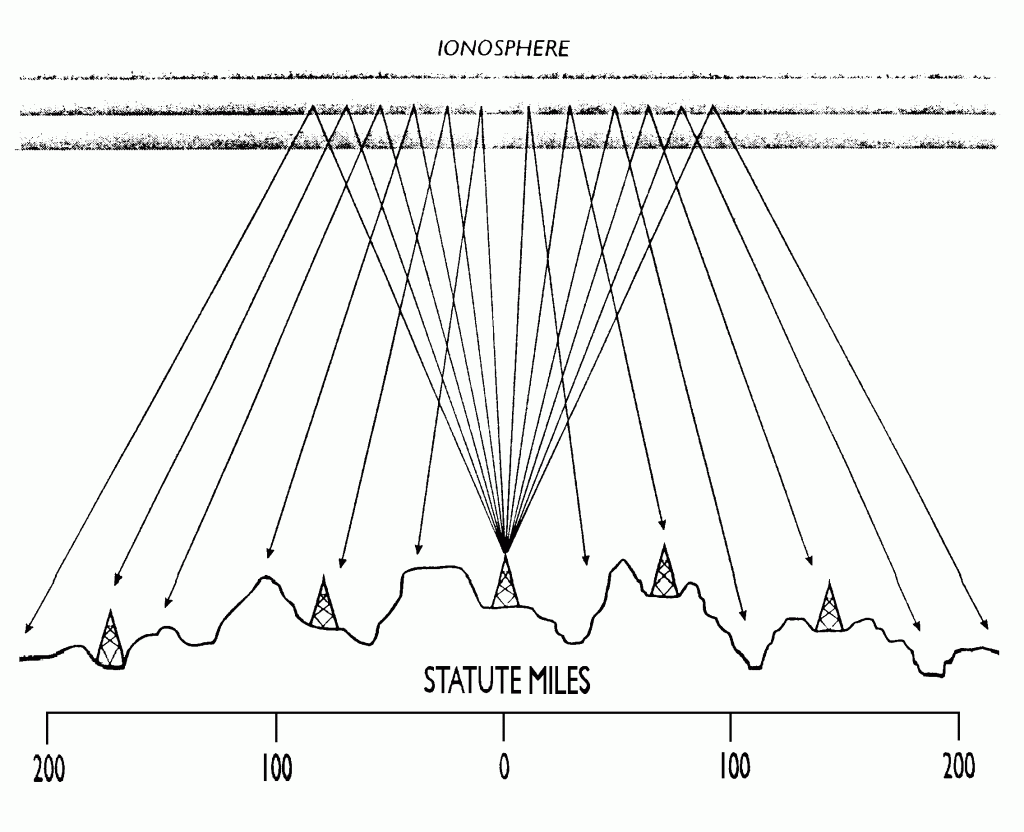What is NVIS?
.. and how do you differentiate it from groundwave propagation?
NVIS means ‘Near -Vertical Incidence Skywave’ propagation and is basically the opposite of DX working. In DX working, we go generally for long-distance contacts.
Fig.1 ‘Ordinary’ Propagation
NVIS addresses local-to-medium range HF communications:
In DX working, both the skywave and ground wave are produced, the extent of the ground wave depending on a number of criteria including terrain earth, power, frequency etc., but is usually quickly attenuated. For the LONGEST distance working we look for the LOWEST angle of radiation, so that the distance to the ionosphere is as long as possible, therefore the fewest number of ‘hops’ are made. In the short-to-medium distance, this produces a zone between where the ground wave ends and the first ‘hop’ lands, which we know as the ‘skip’ zone. Whilst some may look for DX contacts, there are times when short-to-medium distance communications are required, such as WAB/WAI, a net covering a significant amount of the UK, HF DF Contests or for Emergency/Public Service communications – after all, if you can communicate effectively over an area of, say, 300 miles diameter from the deepest wooded valleys, over the highest mountains WITHOUT the aid of repeaters or other forms of relay, it’s well worth considering! Power is not critical either, so low power equipment can be used.
Fig. 2 NVIS Propagation
NVIS or Near Vertical Incidence Skywave works by transmitting at a VERY HIGH TAKE-OFF ANGLE: 70 – 90 degrees. The resulting returned energy returns at a similar angle, without a great deal of attenuation and thus saturates an area of the earth below, providing short-medium range communications WITHOUT GAPS IN COVERAGE. It’s like taking a hose with a spray nozzle and pointing it straight up- the falling water will cover a circular area. The antenna MUST be horizontal or as near this as possible – i.e. NO VERTICALS (although an HF Mobile Whip can be used horizontally). A horizontal antenna also has the effect of providing a better signal-to-noise ratio than a vertical.
The simplest NVIS antenna is the horizontal half-wave dipole at a very LOW height – less than 20ft. The optimum height for an NVIS antenna is reckoned to be between 0.1 to 0.25 of a wavelength above ground, for the particular frequency concerned ( 0.15 of a wavelength is a figure often used ). This can be enhanced by adding a reflecting wire beneath the dipole, parallel with it (obviously, the lower the earth losses, the better). The main idea is to maximize the upward radiation towards the vertical (or zenith) and minimize low-angle sky and ground waves. 40 ( and certainly 80m) dipoles for most Amateurs are difficult to place at the ‘optimum’ of 0.5 wavelength above ground, so there is of course A PROPORTION of high angle radiation therefore from these antennas which may give a certain amount of NVIS propagation, but obviously a knowledge of NVIS techniques enables one to specifically engineer the antenna system to take maximum advantage of the NVIS effect.
Naturally, you don’t get something for nothing and in general NVIS is of course limited to those frequencies which the ionosphere will reflect at anyone time – go too high in freq. and it will just pass through into space. In practical terms, we are talking about 1.8 to 10 MHz, the lower frequencies being used at night. You can use NVIS mobile – but NOT with a vertical whip; it must be made as horizontal as possible. That’s why you will sometimes see military or HF equipped 4WD vehicles on the TV with their whips tied back. NVIS has been known about for a long time (it was actually employed in the ))D-Day(( landings) but up to recently little used. However now it is used by the military, by aid agencies, in the outback expanses of Australia, in Third World countries that have a poor or ravaged telecommunications infrastructure or vast unpopulated areas and for broadcasting in tropical countries.
So how do we determine the optimum frequency for NVIS work?
A very rough guide is to take the higher frequencies (say 6-8 MHz) for daytime working, with the lower (say, 2-4 MHz) for nighttime use, which effectively gives us 40, 80 and 160m. A more accurate method is to follow weekly propagation bulletins or use the several propagation-prediction programs available (Miniprop, for example). A good `working’ frequency for NVIS will often be between 10 – 15% below, i.e. 85% of the FoF2 Critical Frequency – this is the frequency up to which a return can be obtained from a signal directed vertically at the ionosphere.
The Internet has provided us with great assistance over the last few years, in that there is now website access to various propagation information sites, which either give either real-time indications or detailed recent history records of the Critical Frequency. What is a very useful UK site is the Chilton Ionosonde site, which gives a graphical record of the FoF2 Critical Frequency, the MUF and critical frequencies of other ionospheric layers (note that you will have to do a simple registration in order to be able to access the information; in essence it is just looking for your email address and your reason for interest in the data).
Other data is available without login and giving a more global coverage from the IPS Radio and Space Services section of the Australian Government which is a record of the previous hour’s activity.
The FoF2 Critical Frequency information is usually obtained from commercial or scientific ionosounders, which transmit signals directly vertically skywards over a range of frequencies and plot the returns to determine where the Critical Frequency lies at any one time. It is then overlaid in a graphical format over a map of the particular area selected.
In practice, to maintain NVIS communications over a 24hr. period, effectively 3 different frequencies (or bands) are required; a ‘day’ frequency (the highest of the 3), a ‘night’ frequency (lowest of the 3) and a ‘transition’ frequency, somewhere between the other two. Thus antenna-wise either a single antenna covering a wide bandwidth, separate ones for each band or a multiple-dipole format is necessary.
However, it’s not a perfect world and at times optimum frequencies for NVIS don’t fall within Amateur Bands, resulting usually in having to drop to a lower Amateur Band. Whilst you still get a proportion of your signal returned, you have to put up with increased absorption from the other ionospheric layers, plus an increase in the general noise level. This is one reason why the International Amateur Radio Union (IARU) has pushed for some years for a small (even shared) Amateur allocation at around 5MHz, for Emergency Communications and also HF Data (this can suffer from multi-path distortion which is far lessened by using NVIS for short-to-medium distances). A number of countries now have permanent or temporary allocations at 5MHz which are very useful during Sunspot minimum to maintain communications using NVIS.
More information on NVIS can be found in this presentation by Paul G4MWO.
ALE and the future!
As you can probably guess, ALE means something else – Automatic Link Establishment in fact. In the commercial and military world, the problems of changing path conditions, plus the fact that skilled radio operators are getting thinner on the ground, led to the development of ALE. ALE scans and tests authorized frequencies for a particular path or net until it finds a frequency that will support communications over a path. Each radio in an ALE net constantly broadcasts a ‘sounding’ signal and listens for other sounding signals generated by other net members. A quality analysis of these signals by an on-board processor determines the best frequency for communications and this frequency is then selected automatically for operations. This has dramatically increased the efficiency of HF Communications and will obviously be highly useful for NVIS paths. More information on amateur applications of ALE from the HFLINK group.
NVIS Propagation is an area of Amateur Radio that still holds a lot of potential for experimentation and self-training, particularly in the area of antennas, fixed and mobile. Just remember the three main points – Your ANTENNA must be HORIZONTAL, it must be LOW and the CHOICE OF FREQUENCY is all important. It goes without saying that the best results will be obtained if the other station(s) you are working also have NVIS antennas. Have fun!


